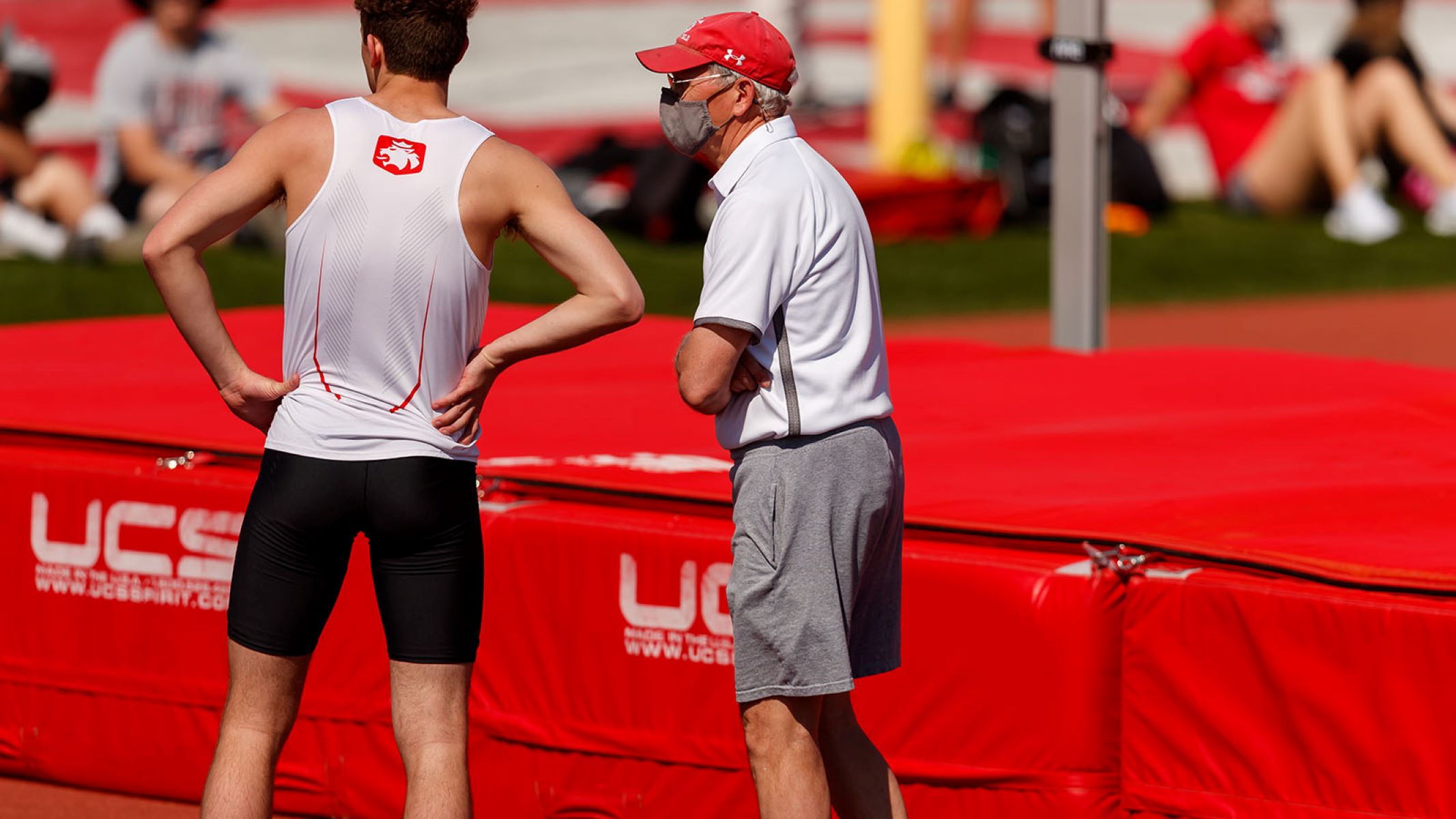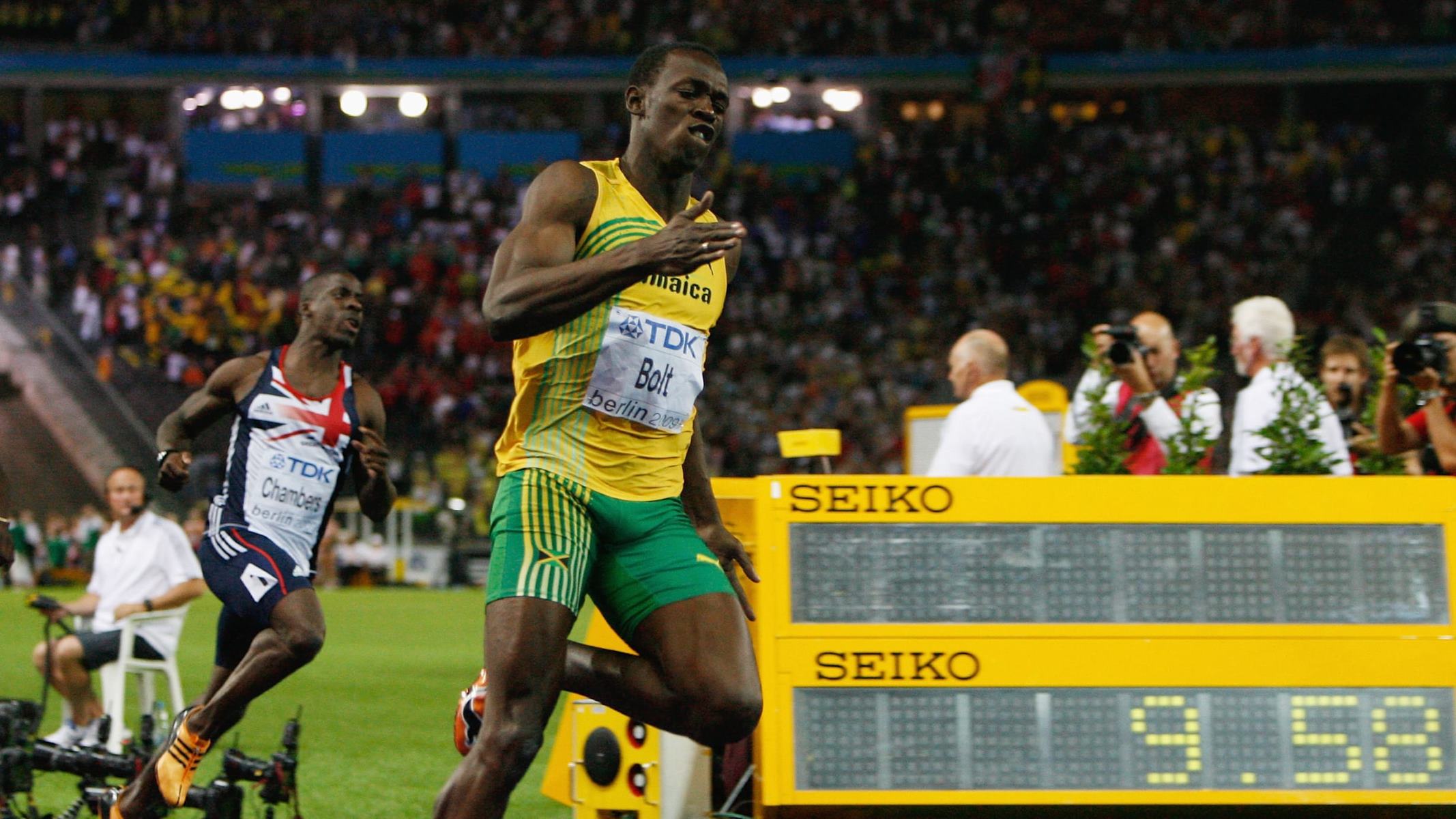

Featured
How To Set Goals For Track And Field
Published: September 3, 2023
Learn how to set effective goals for track and field in this featured guide, providing key tips and strategies for success.
Introduction
Welcome to the exciting world of track and field! Whether you are a seasoned athlete or new to the sport, setting goals is an essential part of your journey to success. Goals provide direction, focus, and motivation, helping you to maximize your potential and achieve greatness.
In track and field, goal setting plays a pivotal role in both individual and team performance. It allows athletes to push their limits, improve their skills, and measure their progress along the way. Whether you’re aiming to break a personal record, qualify for a championship event, or contribute to your team’s success, setting clear and meaningful goals is the key to turning your aspirations into reality.
In this article, we will explore the importance of goal setting in track and field, discuss the factors to consider before establishing goals, examine the different types of goals you can set, and provide practical tips on how to develop an action plan, monitor your progress, and celebrate your achievements.
Goal setting is not just about dreaming big; it’s about turning those dreams into actionable steps. It’s about creating a roadmap that will guide your training, help you stay focused, and propel you towards success. So, let’s dive in and discover the power of setting goals in the world of track and field.
Understanding the Importance of Goal Setting in Track and Field
In the world of track and field, goal setting is more than just a buzzword – it’s a fundamental aspect of success. Setting goals provides athletes with a clear purpose and direction, allowing them to focus their efforts and make consistent progress towards their aspirations.
One of the primary benefits of goal setting in track and field is its ability to provide athletes with motivation and drive. When you have a specific goal in mind, such as breaking a personal record or qualifying for a major competition, it gives you something to strive for. It ignites a fire within you, pushing you to train harder, stay disciplined, and persevere through challenges.
Additionally, setting goals in track and field helps athletes measure their progress and track their improvements. Without goals, it’s challenging to determine whether you’re making any advancements in your performance. But by setting benchmarks and targets, you can objectively assess your development and make adjustments to your training regimen accordingly.
Moreover, goal setting provides structure and focus to your training. When you have a well-defined goal, you can create a step-by-step action plan to achieve it. This ensures that your training is purposeful and tailored to specific areas that need improvement. By targeting specific aspects of your performance, you can optimize your training time, use resources efficiently, and avoid wasting energy on unnecessary exercises.
Furthermore, setting goals in track and field cultivates a growth mindset. It encourages athletes to embrace challenges, learn from failures, and continuously strive for improvement. By setting ambitious but realistic goals, athletes can push their limits, exceed their expectations, and build resilience in the face of obstacles.
Lastly, goal setting in track and field fosters accountability and responsibility. When you set goals, you take ownership of your progress and outcomes. You become more invested in your training, making you more likely to stay committed and disciplined. By holding yourself accountable, you become proactive in seeking opportunities for growth and development.
In summary, goal setting is a fundamental aspect of success in track and field. It provides athletes with motivation, measures progress, provides structure and focus, cultivates a growth mindset, and fosters accountability. By setting clear and meaningful goals, you can unlock your full potential and achieve outstanding results in the dynamic and exhilarating world of track and field.
Factors to Consider Before Setting Goals
Before diving into goal setting in track and field, it’s essential to consider several factors that can influence the effectiveness and feasibility of your goals. By taking these factors into account, you can set yourself up for success and ensure that your goals are realistic and attainable.
The first factor to consider is your current fitness level and skill set. Assess your strengths and weaknesses, understanding where you currently stand in your athletic abilities. This self-awareness will help you set goals that challenge you but are also within your capabilities. Setting goals that are too lofty can lead to frustration and disappointment, while setting goals that are too easy may not provide the necessary motivation for improvement.
Next, consider the time and resources available to you. Evaluate your schedule, commitments, and access to training facilities or coaching. Setting goals that align with your available time and resources ensures that you can consistently work towards them without feeling overwhelmed or excessively constrained. It’s important to balance ambition with practicality to optimize your chances of success.
Another factor to consider is your long-term vision and aspirations in track and field. What are your ultimate goals and dreams? Understanding your bigger picture will help you set more meaningful and aligned shorter-term goals. Your goals should be stepping stones that lead you towards your ultimate vision, keeping you motivated and engaged throughout your track and field journey.
Additionally, take into account any external factors that may impact goal attainment. These could include injuries, personal circumstances, or changes in competition regulations. While it’s important to set ambitious goals, it’s equally important to be adaptable and open to making adjustments when unforeseen circumstances arise. Flexibility in goal setting allows you to navigate challenges and setbacks while maintaining your motivation and focus.
Lastly, consider your support system. Surrounding yourself with a supportive network of coaches, teammates, and mentors can greatly enhance your goal-setting journey. They can provide guidance, accountability, and encouragement along the way. Discuss your goals with them, seek their feedback, and use their expertise to refine your goals and develop an effective action plan.
In summary, several factors need to be considered before setting goals in track and field. Assess your current fitness level, consider your time and resources, align your goals with your long-term aspirations, anticipate external factors, and leverage your support system. By carefully considering these factors, you can set yourself up for success and establish goals that are both challenging and attainable.
Types of Goals in Track and Field
When it comes to goal setting in track and field, there are various types of goals that athletes can strive to achieve. These goals can target different aspects of athletic performance and provide a framework for continuous improvement. Understanding the different types of goals can help you tailor your goal-setting approach to align with your specific needs and aspirations.
One type of goal in track and field is performance-based goals. These goals focus on achieving specific results or milestones in terms of time, distance, or height. For example, setting a goal to break a personal record in the 100-meter sprint or to clear a certain height in the high jump. Performance-based goals provide a clear measurement of progress and serve as a benchmark for improvement.
Another type of goal is skill-based goals. These goals focus on acquiring or improving specific technical skills in track and field events. It may involve working on sprinting technique, perfecting long jump form, or mastering the technique for throwing the shot put. Skill-based goals help athletes enhance their overall performance by honing their fundamental skills in their respective events.
Next, we have process-based goals. These goals focus on the steps, strategies, and habits an athlete needs to develop to achieve their desired performance outcomes. Process-based goals can include goals related to training frequency, nutrition, mental preparation, or recovery techniques. By setting process-based goals, athletes can focus on the controllable factors that will contribute to their overall success.
Developmental goals are another category of goals in track and field. These goals focus on long-term growth, progression, and learning. Developmental goals can involve expanding event repertoire, acquiring new skills, or transitioning to higher levels of competition. These goals encourage athletes to continually challenge themselves, explore new opportunities, and evolve as track and field athletes.
Furthermore, there are goals related to team performance. In track and field, many competitions involve both individual events and team events, such as relay races or team scoring events. Setting team performance goals can involve achieving a specific team ranking, contributing to the team’s overall score, or supporting teammates in their individual performance goals. Team performance goals foster camaraderie, collaboration, and a sense of shared success.
Lastly, personal development goals can be an integral part of goal setting in track and field. These goals focus on the holistic growth of athletes outside of their athletic performance. Examples of personal development goals can include improving mental resilience, developing leadership skills, or maintaining a healthy work-life balance. Personal development goals contribute to the overall well-being and success of athletes both on and off the track.
In summary, there are different types of goals in track and field, including performance-based goals, skill-based goals, process-based goals, developmental goals, team performance goals, and personal development goals. By identifying and setting goals in these various categories, athletes can create a comprehensive goal-setting framework that optimizes their growth, performance, and fulfillment in the dynamic world of track and field.
Setting Specific and Measurable Goals
When it comes to goal setting in track and field, it’s crucial to set goals that are both specific and measurable. Specific goals provide clarity and direction, while measurable goals allow for objective assessment of progress. By setting specific and measurable goals, athletes can enhance their focus, track their advancements, and make adjustments as needed.
A specific goal is one that is clear and well-defined. It answers the questions of what, why, and how. Instead of setting a general goal like “improve sprinting speed,” a specific goal would be “reduce the 100-meter sprint time by 0.5 seconds within three months.” This specific goal provides a target to work towards and guides training efforts more effectively.
Measurable goals, on the other hand, allow for objective assessment of progress. They involve setting tangible criteria or benchmarks that can be measured, tracked, and evaluated. For example, measuring the number of pull-ups an athlete can do or tracking the distance covered in a long jump. Measurable goals provide a sense of accomplishment when progress is evident and help athletes stay motivated along their journey.
By combining specificity and measurability, athletes can set goals that are more compelling and achievable. Instead of simply stating the desire to “improve endurance,” a specific and measurable goal could be “complete a 5-kilometer race under 25 minutes by the end of the season.” This goal provides a clear target, sets a measurable standard, and allows for consistent monitoring of progress.
Moreover, setting specific and measurable goals enables athletes to break down larger objectives into smaller, manageable tasks. By doing so, athletes can create a roadmap that outlines the necessary steps to achieve their goals. These smaller milestones act as building blocks towards the larger, long-term goal, making it more attainable and less overwhelming.
It’s also important to consider the timeframe when setting specific and measurable goals. Establishing a deadline or timeframe adds a sense of urgency and accountability to the goal. Instead of setting an open-ended goal, such as “increase shot put distance,” a specific and measurable goal could be “increase shot put distance by 2 meters within six months.” This time-bound goal provides a sense of focus and helps athletes structure their training plan accordingly.
In summary, setting specific and measurable goals is essential in track and field. By setting goals that are clear, well-defined, and measurable, athletes can enhance their focus, track their progress objectively, break down larger objectives into smaller tasks, and establish a timeline for achievement. With specific and measurable goals, athletes can maximize their potential and realize their aspirations in the exhilarating world of track and field.
Establishing Realistic and Attainable Goals
When setting goals in track and field, it is crucial to establish goals that are both realistic and attainable. While it’s important to strive for greatness and push your limits, setting goals that are too far-fetched or unattainable can lead to frustration and demotivation. By setting realistic and attainable goals, athletes can maintain a sense of focus, confidence, and satisfaction along their journey.
Realistic goals are those that take into account various factors, such as current abilities, resources, and time constraints. They consider the athlete’s starting point and the incremental steps required for growth. Setting realistic goals ensures that athletes set themselves up for success by setting achievable objectives that are within their reach.
When establishing realistic goals, it is essential to consider your current fitness level, skills, and experience. Assess your strengths and weaknesses objectively, and set goals that challenge you without overwhelming you. For example, if your personal record for the 400-meter dash is 1 minute and 10 seconds, setting a goal to break the world record of 43.03 seconds within a year may not be realistic. Instead, setting a goal to improve your time to 1 minute and 5 seconds may be more achievable and satisfying.
Additionally, consider the resources available to you, such as coaching, training facilities, and time commitments. Setting goals that are aligned with your resources ensures that you can consistently work towards them without feeling excessively strained or overwhelmed. It’s essential to strike a balance between ambition and practicality to maximize your chances of success.
Moreover, attainable goals are those that can be realistically achieved based on an athlete’s effort, commitment, and dedication. They consider the necessary steps and progressions required to move from one level to another. Setting attainable goals enables athletes to maintain a sense of belief and motivation throughout their journey.
When establishing attainable goals, it’s important to break larger objectives into smaller, more manageable milestones. This allows athletes to experience a sense of progress and accomplishment along the way. Celebrating these smaller victories boosts confidence and motivates athletes to keep pushing towards their ultimate goals.
Setting realistic and attainable goals also requires a willingness to adapt and adjust as needed. As athletes progress, their goals may need to be revised to reflect new capabilities and aspirations. It’s essential to regularly evaluate and reevaluate goals to ensure they remain challenging yet within reach.
In summary, establishing realistic and attainable goals is crucial in track and field. By setting goals that consider your current abilities, resources, and time constraints, you can set yourself up for success. Break larger objectives into smaller milestones, celebrate achievements along the way, and be prepared to adapt your goals as you progress. By setting realistic and attainable goals, you can maintain motivation, confidence, and a sense of fulfillment in your track and field journey.
Setting Time-Bound Goals
When it comes to goal setting in track and field, setting goals with a specific timeframe is crucial for staying focused, accountable, and motivated. Time-bound goals provide a sense of urgency and help athletes prioritize their efforts. By setting time-bound goals, athletes can better track their progress, make necessary adjustments, and celebrate their achievements within a defined timeframe.
Setting a specific timeframe for your goals creates a sense of urgency and commitment. It provides a deadline by which you aim to accomplish your goal. Without a timeframe, goals may lack a sense of direction and could be easily postponed or neglected. By having a clear deadline in mind, athletes can structure their training and allocate their resources effectively.
When setting time-bound goals, it is important to be realistic and consider the nature of the goal. The timeframe you set should align with the difficulty and complexity of the goal. For example, if your goal is to improve your long jump technique, a realistic timeframe may be six months to a year, allowing for adequate time to practice, make adjustments, and show progress.
Furthermore, setting time-bound goals helps athletes break their larger objectives into smaller, more manageable tasks. These smaller milestones act as checkpoints along the way, allowing athletes to assess their progress and make any necessary adjustments to their training plan. By focusing on achieving these smaller milestones within the allocated time, athletes can stay motivated and maintain a sense of accomplishment.
In addition, time-bound goals enhance accountability. When athletes set a deadline for their goals, they are more likely to stay committed and dedicated to their training. This deadline creates a sense of responsibility and helps athletes manage their time effectively to work towards their goals. It also allows for ongoing evaluation and reflection, enabling athletes to learn from their progress and make informed decisions moving forward.
For time-bound goals to be effective, it’s important to regularly monitor and track progress throughout the defined timeframe. This allows athletes to evaluate their progress, identify any areas that need improvement, and make adjustments as necessary. Regular check-ins help athletes stay on track and ensure that they are progressing towards their goals within the timeline they have set.
Lastly, it’s important to celebrate the achievements and milestones reached within the set timeframe. Recognizing and celebrating these successes provides both motivation and validation, boosting confidence and reinforcing commitment. It also provides an opportunity for athletes to reflect on their progress and adjust their goals for the next timeframe, setting them up for continued growth and success.
In summary, setting time-bound goals is a critical aspect of goal setting in track and field. By setting goals with specific timeframes, athletes create a sense of urgency, prioritize their efforts, and stay accountable. Regular monitoring and evaluation of progress, along with celebrating achievements, ensures athletes stay motivated and on track towards accomplishing their goals. Time-bound goals provide the structure and focus needed for success in the dynamic and time-sensitive world of track and field.
Developing an Action Plan
Setting goals in track and field is not enough on its own; athletes also need a well-developed action plan to turn those goals into reality. An action plan provides a roadmap that outlines the steps and strategies required to achieve your goals. It helps athletes stay organized, focused, and efficient in their training. Developing an action plan is a crucial step towards realizing your ambitions in track and field.
The first step in developing an action plan is to break down your overall goal into smaller, actionable tasks. Identify the specific actions and behaviors that need to be implemented to move closer to your goal. For example, if your goal is to improve your sprinting speed, the tasks may include specific workouts, strength training exercises, and technique drills.
Next, establish a timeline for these tasks. Determine the frequency and duration of each task, as well as the target dates for completion. This timeline provides structure and helps athletes manage their time effectively. It also allows for regular progress monitoring and adjustment of the action plan if necessary.
It’s important to set realistic and attainable expectations when developing an action plan. Be mindful of your current fitness level, resources, and time constraints. If necessary, seek guidance from a coach or trainer to ensure that your action plan aligns with your abilities and circumstances. A well-aligned action plan maximizes your chances of success and prevents injury or burnout.
In addition to tasks and timelines, consider the resources and support required to achieve your goals. Assess what equipment, facilities, coaching, or additional knowledge you may need. Arrange access to these resources and seek the necessary guidance or expertise to support your training efforts effectively. Collaboration with coaches, teammates, or mentors can greatly enhance the execution of your action plan.
Furthermore, incorporate elements of flexibility and adaptability into your action plan. Recognize that circumstances may change, and unexpected challenges may arise. Build in room for adjustments and alternate strategies to address these situations while keeping your progress towards your goals on track. A flexible action plan ensures that you can adapt and overcome obstacles along the way.
Regularly evaluate your progress and adjust your action plan as needed. Monitor your performance and reflect on the effectiveness of your tasks and timelines. Adjustments may include modifying workouts, revising target dates, or incorporating new training techniques. Continuous evaluation and refinement of your action plan help optimize your training efforts and keep you on the path to success.
Remember to stay committed and disciplined in executing your action plan. Consistency is key in achieving your goals. Develop a strong work ethic and stay motivated by tracking your progress, celebrating small wins, and visualizing the ultimate achievement of your goals.
In summary, developing an action plan is a crucial step in goal setting in track and field. Break down your goals into smaller actionable tasks, establish a timeline, consider the necessary resources and support, and incorporate flexibility. Regularly evaluate your progress and make adjustments as needed. By following a well-developed action plan, athletes can effectively progress towards their goals, maximize their potential, and achieve success in the dynamic and challenging world of track and field.
Monitoring Progress and Making Adjustments
Monitoring your progress and making adjustments is a critical aspect of goal setting in track and field. It allows athletes to stay on track, track their advancements, and make necessary changes to their training approach. By regularly assessing your progress and making adjustments as needed, you can optimize your performance and maximize your potential in the sport.
One of the first steps in monitoring progress is to establish measurable benchmarks. These benchmarks serve as indicators of progress and provide a clear way to assess whether you’re moving closer to your goals. For example, if your goal is to increase your long jump distance, regularly measure and record your jumps to track your improvements over time.
Keep a training log or journal to document and track your progress. This log can include details such as the exercises performed, the distance or time achieved, and any noteworthy observations. By consistently recording this information, you can identify patterns, track your improvements, and identify areas where adjustments may be necessary.
Implement regular progress check-ins to evaluate your overall performance. This can be done through self-assessment or with the help of a coach or mentor. Reflect on your training efforts and consider factors such as technique, strength, speed, and endurance. Be honest with yourself and identify areas where you may need to make adjustments to your training program.
Seek feedback from coaches, trainers, or teammates who can provide objective insights and perspectives on your progress. They can identify areas where you may be excelling or where improvement is needed. This external feedback can offer valuable guidance and support in making adjustments to your training approach.
Take note of any barriers or challenges that may be impacting your progress. It could be issues with injury, fatigue, or mental blocks. Identifying these barriers allows you to address them and make necessary adjustments to your training plan. Adapt your workouts, modify techniques, or incorporate recovery strategies to overcome these obstacles and get back on track towards your goals.
Make adjustments to your training plan as needed based on the insights gained from monitoring your progress. This may involve modifying the frequency, intensity, or duration of your workouts or incorporating new exercises or techniques. It’s important to be flexible and adaptable in your approach to ensure continuous improvement.
Regularly evaluate your goals throughout your training journey. As you progress and achieve milestones, you may need to reevaluate and set new goals. This allows you to stay motivated and continuously strive for improvement. Setting new goals keeps you challenged, engaged, and focused on your track and field journey.
Lastly, ensure that you celebrate your achievements along the way. Recognize and reward yourself for the small wins and milestones you achieve as you progress towards your goals. Celebrating achievements provides motivation, boosts confidence, and reinforces your commitment to your track and field aspirations.
In summary, monitoring your progress and making adjustments play a vital role in goal setting in track and field. Regularly assess your performance, seek feedback, address barriers, and adjust your training plan as needed. By monitoring your progress and making necessary adjustments, you can optimize your training, overcome challenges, and maximize your potential for success in track and field.
Celebrating Achievements and Setting New Goals
Celebrating achievements is an essential part of the goal-setting process in track and field. It allows athletes to acknowledge their hard work, dedication, and progress. Celebrating milestones not only boosts motivation and confidence but also sets the stage for setting new goals and continuing the journey of growth and success.
When you achieve a goal, take a moment to celebrate and acknowledge your accomplishment. This can be done through personal reflection, sharing your achievement with friends and family, or even treating yourself to something special. By celebrating your achievements, you reinforce the positive emotions associated with your hard work and dedication.
Reflection is an important aspect of celebrating achievements. Take the time to look back at your journey and appreciate the progress you have made. Consider the obstacles you overcame, the lessons you learned, and the growth you experienced. Reflecting on your achievements allows you to gain insight into your strengths and areas for further improvement.
As you celebrate your achievements, it’s essential to set new goals to maintain your momentum and personal growth. Setting new goals ensures that you continue to challenge yourself, evolve as an athlete, and strive for new heights in your track and field journey. Reflect on your current performance, identify areas that need improvement, and set specific and measurable goals to work towards.
When setting new goals, take into account your previous achievements and the lessons learned from your past experiences. Build on the strength and confidence gained from achieving previous goals as you set new ones. Consider areas where you can push yourself further, such as improving technique, increasing endurance, or reaching higher performance levels.
Ensure that your new goals are realistic and attainable while still being challenging enough to fuel your progress. Set goals that excite and motivate you, while also ensuring they are within your abilities and resources. This balance allows you to maintain focus and commitment throughout your journey.
Break down your new goals into smaller milestones, just as you did with your previous goals. These smaller milestones help you track your progress, maintain motivation, and adjust your training approach as needed. Regularly evaluate your progress and make any necessary modifications to your goals or action plan as you move forward.
Remember to celebrate each milestone achieved along the way to your new goals. Acknowledge your progress, no matter how small, and reward yourself for your accomplishments. Celebrating milestones keeps you motivated, reinforces your commitment, and provides a tangible reminder of your growth and success.
In summary, celebrating achievements is an important part of the goal-setting process in track and field. Take the time to reflect on and celebrate your accomplishments, appreciate your progress, and set new goals to continue your journey of growth and success. By celebrating achievements and setting new goals, you maintain motivation, push your boundaries, and set yourself up for ongoing progress and fulfillment in track and field.
Conclusion
Goal setting is a fundamental aspect of success in track and field. It provides athletes with direction, focus, and motivation to push beyond their limits and achieve their full potential. By setting specific, measurable, realistic, and time-bound goals, athletes can create a roadmap for their training and track their progress along the way.
Understanding the importance of goal setting in track and field is crucial. It cultivates a growth mindset, enhances motivation, and provides structure to training efforts. Setting performance-based, skill-based, process-based, developmental, team performance, and personal development goals allows athletes to target specific areas of improvement and strive for holistic growth.
Before setting goals, factors such as current fitness level, resources, and long-term aspirations need to be considered. This ensures that goals are both challenging and attainable while taking into account individual circumstances and limitations.
Setting specific and measurable goals adds clarity and provides a way to objectively assess progress. Breaking down larger goals into smaller, manageable tasks and establishing a timeline helps athletes stay organized and focused in their training.
Moreover, monitoring progress and making necessary adjustments enable athletes to stay on track and overcome obstacles. Regular reflection, feedback, and evaluation assist in identifying areas for improvement and modifying training plans accordingly.
Celebrating achievements is equally important in the goal-setting process. Recognizing and appreciating the progress made boosts motivation, reinforces commitment, and sets the stage for setting new goals. New goals build upon previous accomplishments and continue the cycle of growth and personal development in track and field.
In conclusion, goal setting is a powerful tool in track and field. It provides athletes with direction, focus, and motivation to strive for excellence. Through setting specific, measurable, realistic, and time-bound goals, monitoring progress, making adjustments, and celebrating achievements, athletes can continually evolve, push their boundaries, and achieve remarkable success in the dynamic and exhilarating world of track and field.







